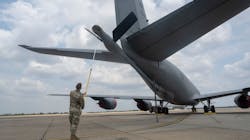Airman’s Innovation Saves Time, Money
By Airman 1st Class Alvaro Villagomez,100th Air Refueling Wing Public Affairs
RAF MILDENHALL, United Kingdom (AFNS) -- Thousands of hours are spent each year removing and installing a boom cover on a KC-135 Stratotanker aircraft – hours that could be used elsewhere. One 100th Maintenance Squadron Airman has invented a new boom cover tool that has the potential to save the U.S. Air Force 40,000 man-hours and approximately $1 million per year.
“I noticed as soon as I got to Mildenhall that removing and installing the boom cover was tedious and time consuming,” said Airman 1st Class Jacob Helzer, 100th MXS hydraulics maintenance journeyman. “Removing the cover the conventional way involves calling the Aerospace Ground Equipment backshop for an aircraft stand and requires two Airmen and a substantial amount of time.”
The current conventional method hinders daily operations, whereas the innovative solution Helzer created is easier, takes less time and lessens the impact on the flow of operations.
“One of the maintenance crew chiefs reached out because he knew I enjoy 3-D printing and design and believed I could come up with a solution for the boom cover,” Helzer said. “I then came up with a prototype for a tool that could make the process much smoother.”
Tech Sgt. Steven Jakubowski said Helzer is always looking for ways to innovate and constantly asking questions to gain further knowledge.
“He spent a lot of his free time, outside of work, designing the boom cover tool,” Jakubowski said.
Helzer, using his skill and knowledge with 3-D printing, created a prototype called the “Boom Cover Tool.” The tool was manufactured with Helzer’s 3-D printer and resembles a butterfly net on the end of a retractable pole with a hoop mechanism that tightens and loosens the net covering on the opposite end.
“Once I created the prototype, I brought it to my section and tested it out,” Helzer said. “A 30-minute job became a one-minute job with the Boom Cover Tool.”
The Boom Cover Tool greatly reduces the number of man-hours needed every time a cover needs to be removed or installed on an aircraft and the cover itself better protects the boom pod during adverse weather conditions.
Each Boom Cover Tool costs roughly $200 to produce.
“The projected savings were calculated by him and I while submitting for Spark Tank by using the 2021 comptroller document for wages,” Jakubowski said.
“I did the math and the projected savings for the Air Force if they utilized the Boom Cover Tool for the entirety of the refueling fleet would be approximately $1 million and potentially 40,000 man-hours annually,” Helzer added.
In order to meet this goal, Helzer has been collaborating with the MXS fabrication flight to produce the test prototypes for each aircraft here.
“Once we have everything streamlined, we can move into the beta testing phase, which is roughly six months, then move on to scaling up for the entire KC-135 Stratotanker aircraft fleet,” Helzer said.
Moving forward, Helzer plans on developing a batch of tools for the local KC-135 fleet to prove the design concept. Helzer would then like to contract the fabrication of a final, more durable prototype and share the Boom Cover Tool throughout the entire fleet and modify the design to be adopted for other variations of refueling aircraft.
“Helzer has been a go-getter from the moment he arrived on station and is always hungry to learn all aspect of his job, and his critical thinking skills are some of the bests I’ve ever seen,” Jakubowski said.
Helzer has always been motivated to improve himself and the way things are done at his job, and one example of this is the Boom Cover Tool.
“This is how change starts, by questioning the way we do things and coming up with a solution that will benefit Airmen at all levels,” Helzer said. “I created the Boom Cover Tool to make the lives of my Wingmen easier and inspire Airmen to devise and implement new ideas to help improve even the simplest tasks.”
